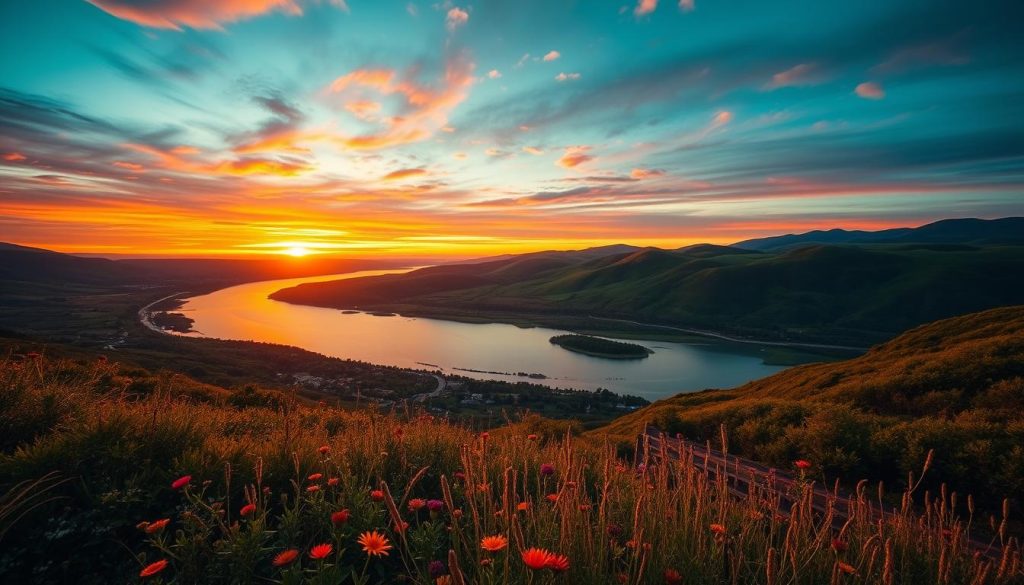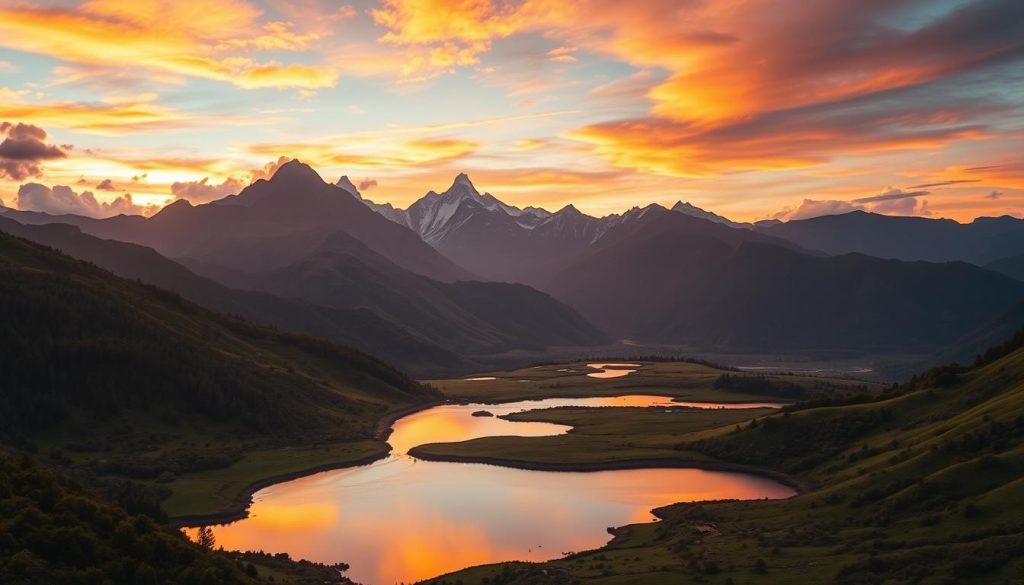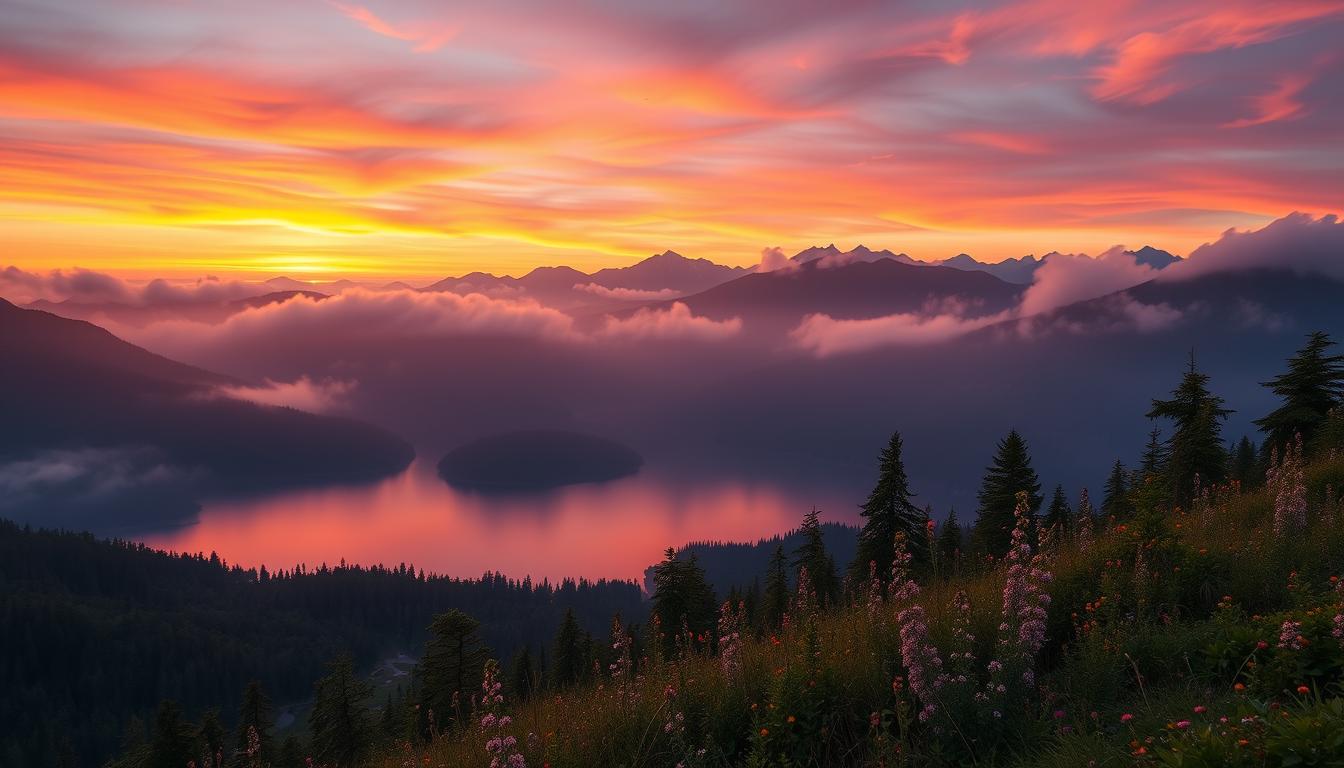I’m excited to share my top tips for capturing nature’s beauty with you. Whether you’re new or experienced, this guide has everything you need. You’ll learn how to take amazing outdoor photos, handle changing light, and choose the best gear for your trips.
Landscape photography is a special way to keep nature’s beauty alive. It lets us show off the world’s beauty, from big views to small details. By learning the basics, you can make photos that show off the beauty around you and your feelings for nature.
We’ll look at many parts of landscape photography next. We’ll talk about how to arrange your shots, use the golden hours, and pick the right equipment. Let’s explore how to capture nature’s beauty together.
Mastering the Art of Landscape Photography
Landscape photography is about capturing the natural world’s essence. To master it, you need to understand the environment and light changes. We’ll look at the golden hours, when light is soft and warm, ideal for outdoor shots.
Understanding the Essence of Nature
Good landscape photography needs a keen eye for details. Observe your surroundings and get lost in the environment. Notice light and shadow, textures, and the unique character of each place. This helps you take more compelling photos.
Embracing the Golden Hours
The golden hours, before sunrise and after sunset, have amazing light. The sun’s warm glow makes your subject look stunning. Try different camera settings to capture the vibrant colors and shadows of the golden hours.
| Technique | Description |
|---|---|
| Landscape Photography Techniques | Mastering the art of landscape photography requires a deep understanding of the environment and the ever-changing lighting conditions that can transform a scene. |
| Nature Photography Composition | Successful landscape photography requires a keen eye for the intricate details and patterns that make the natural world so captivating. |
| Lighting for Landscape Photography | The golden hours, the periods just before sunrise and after sunset, offer some of the most breathtaking lighting conditions for landscape photography. |
| Outdoor Photography Lighting | Experiment with different camera settings to capture the rich, vibrant colors and dramatic shadows that define the golden hours. |
Landscape photography tips: Composition Techniques

Composition is key to great landscape photos. Learning to compose your shots can make them stand out. The rule of thirds is a classic technique that works well.
The Rule of Thirds: A Timeless Classic
The rule of thirds is a basic rule in landscape photography composition. It divides your frame into nine parts. Place important parts like the horizon on these lines for balance.
Using the rule of thirds can make your photos better. It puts the focus off-center, making the photo more interesting. This draws the viewer’s eye to the best parts.
Learning the rule of thirds is important for outdoor photos. Try different horizon placements to see how it changes your photos.
The rule of thirds is a guide, not a strict rule. Sometimes, breaking it can lead to amazing photos. The goal is to know the rules and then use your own style.
Capturing Breathtaking Vistas: Essential Gear

For landscape photography, the right gear is crucial. Whether you’re new or experienced, good landscape photography gear and outdoor photography equipment are key. We’ll look at the camera gear for landscape photography that can improve your images.
The Camera Body
The camera body is the base of your setup. While megapixels matter, consider sensor size, dynamic range, and low-light performance too. Choose a camera that excels in these areas for detailed, high-quality images in any light.
Lenses for Landscape Photography
The right lens is vital. Wide-angle lenses are great for sweeping views and dramatic shots. Look for lenses between 16-35mm for wide shots. Also, get a telephoto lens (70-200mm) to focus on specific parts of the scene.
Tripods and Accessories
A sturdy tripod is crucial for landscape photography gear. It lets you shoot longer, get sharper images, and try creative techniques. Don’t forget a remote shutter release, ND filters, and a polarizing filter to enhance your photos.
| Gear | Recommendation | Key Benefits |
|---|---|---|
| Camera Body | Sony a7R IV | High-resolution sensor, excellent dynamic range, and advanced autofocus capabilities |
| Wide-Angle Lens | Nikon 16-35mm f/4G ED VR | Versatile focal length range, high image quality, and built-in vibration reduction |
| Telephoto Lens | Canon EF 70-200mm f/2.8L IS III USM | Exceptional sharpness, fast aperture, and effective image stabilization |
| Tripod | Manfrotto 190go! XPRO Aluminum Tripod | Sturdy, lightweight, and easily adjustable for optimal camera positioning |
Remember, the key to amazing landscape photos is to try different camera gear for landscape photography. Find what works best for you. With the right tools and a keen eye, your photos can soar.
Post-Processing: Enhancing Your Landscape Images

As a landscape photographer, post-processing is key. It helps make your images stand out. With photo editing software, you can turn raw photos into beautiful art.
Editing Software: Unleashing Your Creativity
Adobe Lightroom and Photoshop are great tools for editing. They let you adjust exposure and colors. You can also add filters and overlays to make your photos pop.
Developing a Consistent Style
It’s important to find your own style in editing. This makes your work unique. A consistent style helps your photos stand out in the world of landscape photography.
Post-processing is where you bring your vision to life. Don’t be shy to try new things. Find what works best for you.
Finding Inspiration: Exploring Nature’s Wonders
As a landscape photographer, finding inspiration is a never-ending journey. The world is full of amazing natural wonders. From tall mountains to calm coastlines, we get to capture these stunning scenes. Exploring all that Mother Nature offers helps us see things in new ways and grow creatively.
Places like the Pacific Northwest’s cliffs, Patagonia’s landscapes, and the Himalayas’ peaks are unique. Each spot brings its own challenges and chances. By diving into these places, we learn to see the world in a new way.
When I explore these nature photography destinations, I’m always inspired. The light, colors, and shapes of nature amaze me. The sun’s glow on misty mountains or waves hitting rocks are moments that spark my love for landscape photography inspiration. By paying attention to nature’s changes, we find new ways to create and explore our outdoor photography locations.

